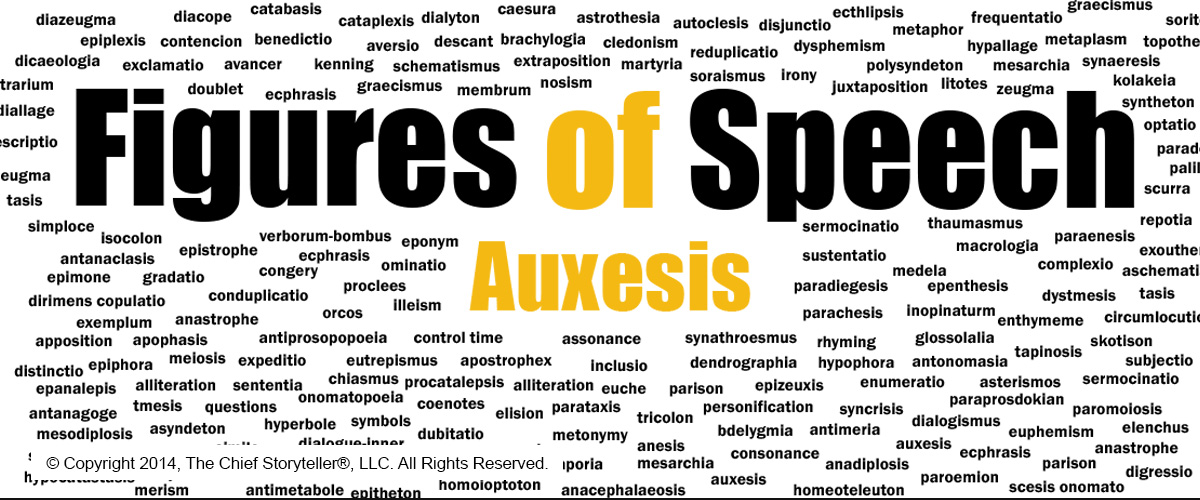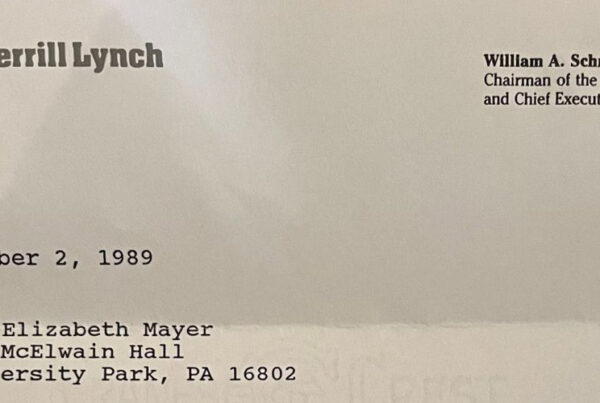
Let me introduce you to Auxesis, a Figure of Amplification. It occurs when you place your words or phrases in a climatic order.
This article is part of a growing series on figures of speech and story elements. I share them as the English language has hundreds of literary devices to help you (dramatically) improve the effectiveness and impact of your various communications.
Use Auxesis to strengthen your written and spoken narrative with amplification, emphasis, and emotion. In addition, Auxesis improves the memorability of your words.
When I do my consulting, workshops, training, and teach my class on public speaking and storytelling (I’m an adjunct professor at The Robert H. Smith School of Business at the University of Maryland), I tell them all…
“You never have to remember the actual Greek word for the figure of speech.
You DO have to remember the concept and proper use of it.”
Emphasis & Impact Figures of Speech include Anadiplosis, Anaphora, Asyndeton, Diacope, Epanalepsis, Epiphora, and Polysyndeton.
Amplification Figures of Speech include Auxesis and Epizeuxis,
Figures of Sound include Onomatopoeia.
Other Figures of Speech include Procatalepsis and Portmanteau.
There are three major sections:
- Figure of Speech. Includes a little background, usage, definition, pronunciation, other related figures of speech, and etymology.
- Usage Guidelines. Follow these guidelines to ensure maximum impact.
- Examples of Auxesis. Find examples from speeches, presentations, presidential addresses, poems, music, and more
1) AUXESIS – FIGURE OF AMPLIFICATION
A Figure of Speech is…
figurative language in the form of a single word or phrase/clause. It can be repetition, arrangement, word or words, or omission of words. It can be a literal meaning or a specialized meaning. In the end, a figure of speech is used for rhetorical or vivid effect to improve your communication effectiveness in your spoken, written, and on-line communications.
Specific information related to Auxesis includes:
| Definition | Auxesis is when you place words or phrases in a climatic order, to deliberately emphasize, intensify, or overstate. As each word/phrase is read or spoken, importance clearly increases in an obvious way, contrasted with the previous item. |
| Pronunciation | awk – zee – sis |
| Related to | Hyperbole (is a form of Auxesis); Meiosis is the opposite, where you understate something; Catacosmesis is also the opposite with a series of clauses with decreasing force. |
| Etymology | The Greek word for growth, increase, and amplification is αὔξησις, aúxēsis. It came from the Greek verb “auxánein,” which means, “to grow.” |
2) USAGE GUIDELINES
Here are some guidelines for you to ensure Auxesis achieves your communication goals:
| Use Deliberately | The strength of Auxesis as an amplification figure of speech, is to use it deliberately. In your typical three-minute story, which is about 450 words, use Auxesis no more than three to four times. |
| Make it Obvious |
To ensure your use of Auxesis achieves its desired outcome, make your choice of words obvious. Be clear in how the words build to |
| Emphasize with Your Voice | In my training and teaching, I share specifics on how to use one’s voice to add (dramatic) impact to your spoken communication. Think of yourself as an orchestra with three main instruments: Your Words, your Body Language, and your Voice. Varying your tone of voice, cadence, and speed are what separates a great speaker from a good speaker. |
3) EXAMPLES OF AUXESIS
Look at the examples below. See how Auxesis is used to dramatically increase your words’ effectiveness and impact. Then experiment, mixing and combining other figures of speech in your written, spoken, and social media communication.
Example 1: Earth Force – Relict Legacy Book 1, Shemer Kuznits
| Without Notation | On the first day, a mist descended from the heavens blanketing earth. On the second day, a cryptic message, “Infusion commencing,” appeared in the corner of everyone’s eyes. On the third day, the sick were healed and the crippled walked again. On the fourth day, celebration and joy spread across the globe. And on the fifth day, the warping began… |
| With Notation |
On the first day, a mist descended from the heavens blanketing earth. On the second day, a cryptic message, “Infusion commencing,” appeared in the corner of everyone’s eyes. On the third day, the sick were healed and the crippled walked again. On the fourth day, celebration and joy spread across the globe. And on the fifth day, the warping began… |
| Note 1: { On the } starts each sentence. This is an example of Anaphora. Note 2: { day } is an example of Epiphora. |
Example 2: Chick-fil-A Soda Drink Cup
| Without Notation | Sip. Sip. Joy. |
| With Notation |
Sip. Sip. Joy.
Joy is the exaggerated word in the phrasing. |
| Note 1: { Sip. Sip. Joy. } is an example of Asyndeton. Note 2: { Sip } is an example of Onomatopoeia. Note 3: { Sip. Sip. } is an example of Alliteration. Note 4: { Joy } is an example of Hyperbole. (or perhaps it is joy?). Note 5: { Joy } is an example of Personification. |
Example 3: Article About The Rings of Power TV Show
| Without Notation | After five years of development, The Rings of Power will finally premiere Sept. 2 on Amazon Prime Video. With a record-setting price tag of $1 billion, it will be the most expensive show ever made. No other series in the history of television has been this sprawling, this cinematic, this massive—or launched with such secrecy under such external pressure.
– Eliana Dockterman, Time, 15 August 2022 |
| With Notation |
After five years of development, The Rings of Power will finally premiere Sept. 2 on Amazon Prime Video. With a record-setting price tag of $1 billion, it will be the most expensive show ever made. No other series in the history of television has been this sprawling, this cinematic, this massive—or launched with such secrecy under such external pressure. |
| Note 1: { such … such } is an example of Diacope and Alliteration. Note 2: { this sprawling, this cinematic, this massive } is an example of Asyndeton. Note 3: { this … this … this } starting each clause is an example of Anaphora. |
Example 4: Insight from Xunzi (One of the Three Greatest Confucian Scholars)
| Without Notation | What I hear I forget, what I see I remember, what I do I understand.
不闻不若闻之,闻之不若见之,见之不若知之,知之不若行之;学至于行之而止矣。 |
| With Notation |
What I hear I forget, what I see I remember, what I do I understand.
不闻不若闻之,闻之不若见之,见之不若知之,知之不若行之;学至于行之而止矣。 – Xunzi (One of the Three greatest Confucian Scholars), Ru2 Xiao4 Pian1, 340 – 245 BCE |
| Note 1: { I repeated six times } is an example of Diacope. Note 2: { the three clauses together } is an example of Asyndeton. Note 3: { what I … what I … what I } starting each clause is an example of Anaphora. |
Example 5: Pirates of the Caribbean Dialogue
| Without Notation | She’s safe, just like I promised. She’s all set to marry Norington, Just like she promised. And you get to die for her, just like you promised. |
| With Notation |
She’s safe, just like I promised. She’s all set to marry Norington, Just like she promised. And you get to die for her, just like you promised.– Captain Jack Sparrow, Pirates of the Caribbean, Dialogue with Will Turner about his beloved Elizabeth |
| Note 1: { promised … promised … promised … } is an example of Epiphora. Note 2: { she’s … she’s … } and { just like … just like … } are examples of Anaphora. |
References: I use a combination of my experience, my personal library of books and journals, sources from the Internet, and my 710-plus page Story Elements Resource Guide. My favorite sources include, in alphabetical order: American Rhetoric, Encyclopedia Britannica, LitCharts, Literary Devices, Merriam-Webster Dictionary, Oxford English Dictionary, Silva Rhetoricae, and ThoughtCo. My favorite books include: A Handbook of Rhetorical Devices by Robert A. Harris; Elements of Eloquence by Mark Forsyth; and A Handlist of Rhetorical Terms, 2nd Edition by Richard A. Lanham.
Updated: 2023
Photography Source: Message Cloud/Word Cloud designed by The Chief Storyteller®, LLC. © Copyright 2023. All Rights Reserved.
#chiefstoryteller #communication #figuresofspeech #language #rhetoric



